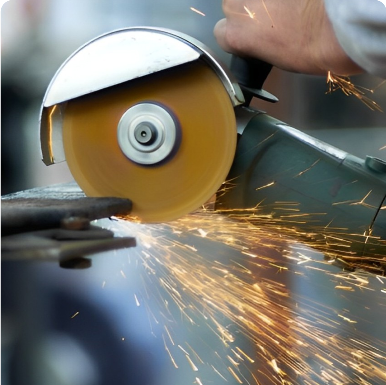Understanding Cutting Wheels for Metal A Comprehensive Guide
Cutting wheels, also known as abrasive discs, are vital tools in metalworking and fabrication industries. They are specifically designed to cut through metals with precision and efficiency. This article will explore the features, types, applications, and safety measures associated with cutting wheels for metal, providing a comprehensive understanding of this essential tool.
Features of Cutting Wheels
Cutting wheels are composed of abrasive materials, usually bonded together with a resin or other binding agents. The quality and composition of these materials greatly influence the wheel's performance. A good cutting wheel should possess the following features
1. Durability High-quality cutting wheels are designed to withstand the rigors of metal cutting without excessive wear, ensuring longevity.
2. Precision The wheel's design should enable accurate cuts without causing damage to the workpiece, providing clean edges and minimal burrs.
3. Heat Resistance During the cutting process, friction generates heat. A good cutting wheel should remain stable and resist degrading or warping under these conditions.
4. Versatility While some wheels are designed for specific materials, others can cut through a variety of metals, including steel, aluminum, and stainless steel.
Types of Cutting Wheels
There are several types of cutting wheels available in the market, each designed for specific applications
1. General-Purpose Cutting Wheels These wheels are suitable for cutting a variety of metals and are ideal for general applications in workshops.
2. Metal-Specific Wheels Some cutting wheels are optimized for materials such as stainless steel or aluminum, containing special abrasives that enhance performance with those specific metals.
4. Thicker Wheels Generally 1/8 inch or thicker, these wheels are more robust and provide extended life for heavy-duty applications but may produce more heat.
cutting wheel metal

5. Specialty Wheels Wheels designed for niche applications such as reinforced cutting for thicker metals or high-speed applications are also available.
Applications of Cutting Wheels
Cutting wheels have a wide range of applications in various industries including
- Metal Fabrication Used for cutting metal sheets, pipes, and profiles. - Automotive Industry Essential in vehicle repair and maintenance for cutting body panels and exhaust systems. - Construction Useful in remodelling projects and cutting rebar and metal studs. - Aerospace Used for precision cutting in aircraft components.
Safety Measures
While cutting wheels offer incredible utility, it’s crucial to observe safety precautions to prevent accidents. Here are important safety measures to consider
1. Personal Protective Equipment (PPE) Always wear safety glasses, gloves, and protective clothing to safeguard against sparks and metal shards.
2. Proper Equipment Setup Ensure that the cutting wheel is correctly mounted on the tool with tight fittings to prevent dislodging during use.
3. Speed Ratings Adhere to the manufacturer's specifications regarding the maximum RPM to avoid catastrophic failures of the wheel.
4. Environment Maintain a clutter-free workspace and ensure adequate ventilation to dissipate heat and debris.
5. Inspection Regularly inspect cutting wheels for signs of wear, damage, or cracks before use.
Conclusion
Cutting wheels for metal are indispensable tools in various cutting applications, offering precision and efficiency when used correctly. By understanding their features, types, and safety practices, users can maximize their potential while minimizing risks associated with their use. Whether for professional or DIY projects, choosing the right cutting wheel can significantly affect the quality of work and overall safety in the workspace.
Post time:Dec - 01 - 2024

















